Enhancing Geothermal Anomaly Detection with Multi-Source Thermal Infrared Data: A Case of the Yangbajing–Yangyi Basin, Tibet
Abstract
1. Introduction
2. Geological Setting
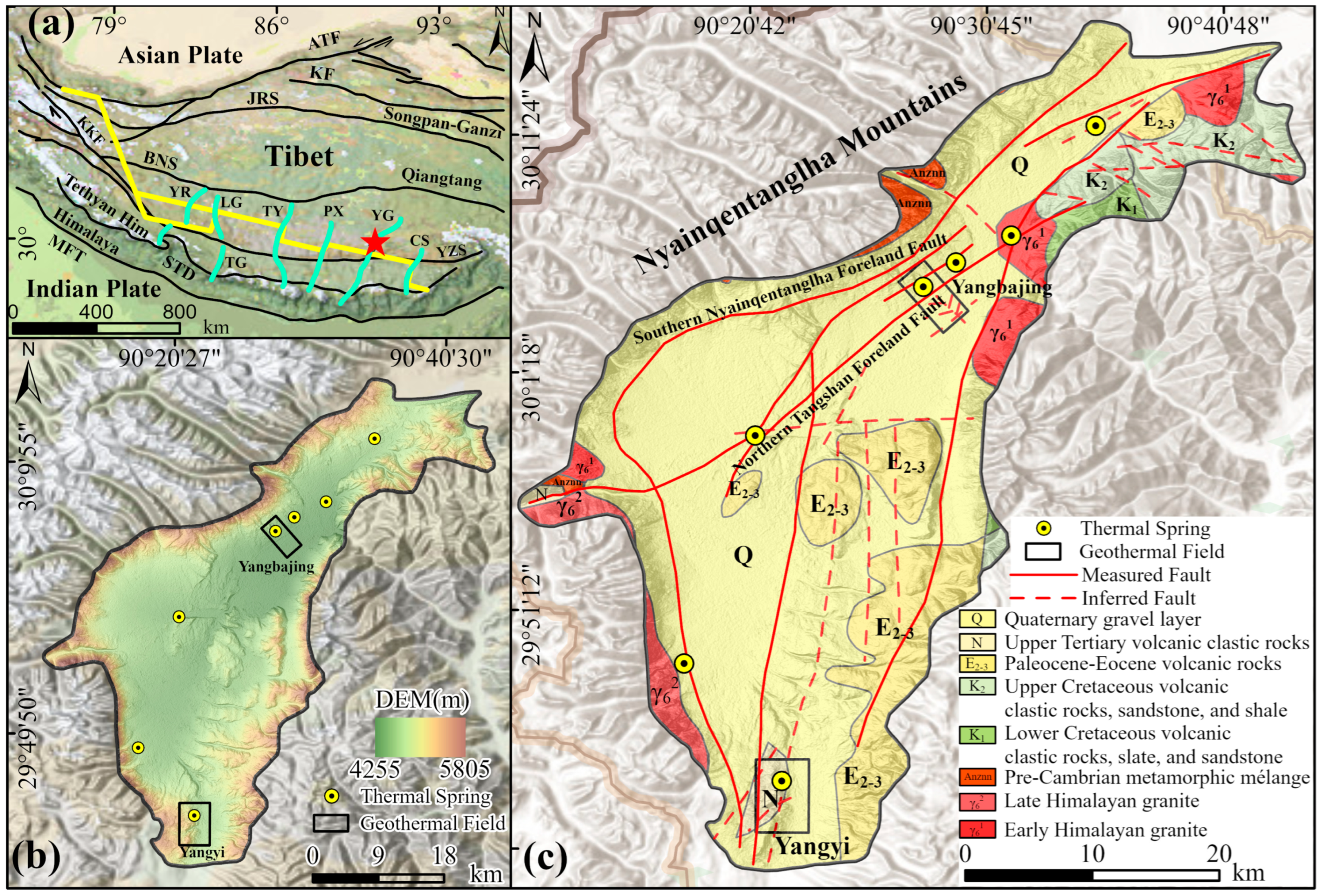
3. Materials and Methods
3.1. Landsat 8 LST Data Products and Time-Series Processing
3.2. ASTER LST Data Product and D–S Evidence Theory Fusion Method
3.3. Combined Processing of Daytime and Nighttime LST Data
3.4. MODIS NLST Analysis and Magma Chamber Identification
4. Result
4.1. Daytime LST Anomalies Extracted from Landsat 8 Data
4.2. Nighttime LST Anomalies Extracted from ASTER LST Data
4.3. Geothermal Anomalies from Combined Daytime and Nighttime LST
4.4. Distribution Characteristics of Geothermal Anomalies Detected by MODIS NLST
5. Discussion
5.1. Integration and Optimization of Multi-Source LST Data for Geothermal Anomaly Detection
5.1.1. Anomaly Extraction and Method Optimization of Landsat-8 LST Data
5.1.2. Multi-Perspective Integration and Extraction Analysis of ASTER NLST Data
5.1.3. Geothermal Anomaly Stability from Joint Daytime and Nighttime LST Analysis
5.2. Magma Chamber Dynamics from MODIS NLST Data
5.3. Relationship Between Day–Night Anomalies and Magmatic Heat Sources
5.4. Limitations and Future Improvements
6. Conclusions
Author Contributions
Funding
Institutional Review Board Statement
Informed Consent Statement
Data Availability Statement
Acknowledgments
Conflicts of Interest
References
- Wang, G.; Lu, C. Progress of geothermal resources exploitation and utilization technology driven by carbon neutralization target. Geol. Resour. 2022, 31, 412. [Google Scholar]
- Huan, W.; Bing, M.; Lingxiao, J.; Yang, Y.; Jiaxiu, H.; Wei, W. The Role, Supply and Demand of Critical Minerals in the Clean Energy Transition under Carbon Neutrality Targets and Their Recommendations. Geol. China 2021, 48, 1720–1733. [Google Scholar]
- Li, J.; Gallego-Schmid, A.; Stamford, L. Integrated Sustainability Assessment of Repurposing Onshore Abandoned Wells for Geothermal Power Generation. Appl. Energy 2024, 359, 122670. [Google Scholar] [CrossRef]
- Tannock, L.; Wang, Y.; Li, J.F.; Liu, J.; Zhang, K.; Xu, L.; Regenauer-Lieb, K. A Preliminary Study on the Mechanics and Tectonic Relationship to the Geothermal Field of the Heyuan Fault Zone in Guangdong Province. J. Geomech. 2019, 25, 400–411. [Google Scholar]
- Zhao, P.; Dor, J.; Xie, E.J.; Jin, J. Strontium Isotope Data for Thermal Waters in Selected High-Temperature Geothermal Fields, China. Acta Petrol. Sin. 2003, 19, 569–576. [Google Scholar]
- Duo, J. The Basic Characteristics of the Yangbajing Geothermal Field—A Typical High Temperature Geothermal System. Eng. Sci. 2003, 5, 42–47. [Google Scholar]
- Chen, W.; Xue, G.; Zhao, P.; Ren, W.; He, Y.; Lü, P.; Lei, K.; Zhao, Y. SOTEM Exploration and Reservoir Structure Analysis of Yangbajain Geothermal Field, Xizang. Chin. J. Geophys. 2023, 66, 4805–4816. [Google Scholar]
- Yan, J. Study on the Resistivity Structure and Geothermal Genesis Mechanism of Gudui Geothermal Field in Tibet, China. Geothermics 2024, 119, 102929. [Google Scholar] [CrossRef]
- Maryadi, M.; Sari, E.K.; Zarkasyi, A.; Mizunaga, H. Three-Dimensional Magnetotelluric and Gravimetric Imaging of Mount Lawu Geothermal Prospect Area, Indonesia. Geothermics 2024, 118, 102917. [Google Scholar] [CrossRef]
- Lei, H.W.; Bai, B.; Cui, Y.X.; Xie, Y.C.; Li, J.; Hou, X.W. Quantitative Assessment of Calcite Scaling of a High Temperature Geothermal Production Well: Hydrogeochemistry—Application to the Yangbajing Geothermal Fields, Tibet. Earth Sci. 2023, 48, 935–945. [Google Scholar]
- Ayari, J.; Barbieri, M.; Boschetti, T.; Barhoumi, A.; Sellami, A.; Braham, A.; Manai, F.; Dhaha, F.; Charef, A. Major- and Trace-Element Geochemistry of Geothermal Water from the Nappe Zone, Northern Tunisia: Implications for Mineral Prospecting and Health Risk Assessment. Environments 2023, 10, 151. [Google Scholar] [CrossRef]
- Shang, J.; Liu, M.; Cao, Y.; Shi, H.; Wei, X. Trace Element Geochemistry of High-Temperature Geothermal Waters in the Yunnan-Tibet Geothermal Province, Southwest China. Appl. Geochem. 2024, 162, 105910. [Google Scholar] [CrossRef]
- Bozkaya, Ö.; Bozkaya, G.; Akın, T.; Atan, H. Mineralogical and Geochemical Characteristics of Alteration Minerals Related to Fossil Geothermal Activities in the Kızıldere Geothermal Field, Western Turkey. Geochemistry 2024, 84, 126082. [Google Scholar] [CrossRef]
- Mahboob, M.A.; Genc, B.; Celik, T.; Ali, S.; Atif, I. Mapping Hydrothermal Minerals Using Remotely Sensed Reflectance Spectroscopy Data from Landsat. J. S. Afr. I Min. Metall. 2019, 119, 279–289. [Google Scholar] [CrossRef]
- Chen, Z.; Dong, Q.; Chen, J.; Zhao, W.; Jiang, L.; Zhang, G.; Feng, T.; Wang, D.; Bi, X.; Bian, M. Research on Quantitative Prediction and Evaluation of Geothermal Anomaly Area in Qamdo-Nyingchi Section of Sichuan-Tibet Railway. Remote Sens. Technol. Appl. 2021, 36, 1368–1378. [Google Scholar]
- Jiangqin, C.; Zhao, Z.; Lai, Z.; Xu, S.; Liu, J.; Li, Z.; Zhang, X.; Chen, Q.; Yang, H.; Zhao, X. Detecting Geothermal Anomalies Using Landsat 8 Thermal Infrared Remote Sensing Data in the Ruili Basin, Southwest China. Environ. Sci. Pollut. Res. 2022, 30, 32065–32082. [Google Scholar] [CrossRef]
- Wang, K.; Jiang, Q.; Yu, D.; Yang, Q.; Wang, L.; Han, T.; Xu, X. Detecting Daytime and Nighttime Land Surface Temperature Anomalies Using Thermal Infrared Remote Sensing in Dandong Geothermal Prospect. Int. J. Appl. Earth Obs. 2019, 80, 196–205. [Google Scholar] [CrossRef]
- He, J.; Zheng, B.; Li, W.; Yang, L.; Sun, H. Land Surface Temperature Retrieval of the Geothermal Area in Eastern Liaoning, China, Based on Thermal Infrared Remotely Sensed Data of MODIS. J. Indian Soc. Remote Sens. 2018, 46, 1023–1034. [Google Scholar] [CrossRef]
- Chao, J.; Zhao, Z.; Xu, S.; Lai, Z.; Liu, J.; Zhao, F.; Yang, H.; Chen, Q. Geothermal Target Detection Integrating Multi-Source and Multi-Temporal Thermal Infrared Data. Ore Geol. Rev. 2024, 167, 105991. [Google Scholar] [CrossRef]
- Zhao, F.; Peng, Z.; Qian, J.; Chu, C.; Zhao, Z.; Chao, J.; Xu, S. Detection of Geothermal Potential Based on Land Surface Temperature Derived from Remotely Sensed and In-Situ Data. Geo-Spat. Inf. Sci. 2023, 27, 1237–1253. [Google Scholar] [CrossRef]
- Dong, B.; Dong, S.; Wang, Y.; Wen, F.; Yu, C.; Zhou, J.; Song, R. Detecting Geothermal Resources in a Plateau Area: Constraints From Land Surface Temperature Characteristics Using Landsat 8 Data. Front. Earth Sci.-Switz. 2022, 10, 785900. [Google Scholar] [CrossRef]
- Liu, S.; Ye, C.; Sun, Q.; Xu, M.; Duan, Z.; Sheng, H.; Wan, J. Detection of Geothermal Anomaly Areas With Spatio-Temporal Analysis Using Multitemporal Remote Sensing Data. IEEE J. Sel. Top. Appl. Earth Obs. Remote Sens. 2021, 14, 4866–4878. [Google Scholar] [CrossRef]
- Darge, Y.M.; Hailu, B.T.; Muluneh, A.; Kidane, T. Detection of Geothermal Anomalies Using Landsat 8 TIRS Data in Tulu Moye Geothermal Prospect, Main Ethiopian Rift. Int. J. Appl. Earth Obs. Geoinf. 2019, 74, 16–26. [Google Scholar] [CrossRef]
- Romaguera, M.; Vaughan, R.G.; Ettema, J.; Izquierdo-Verdiguier, E.; Hecker, C.A.; van der Meer, F.D. Detecting Geothermal Anomalies and Evaluating LST Geothermal Component by Combining Thermal Remote Sensing Time Series and Land Surface Model Data. Remote Sens. Environ. 2018, 204, 534–552. [Google Scholar] [CrossRef]
- Gemitzi, A.; Dalampakis, P.; Falalakis, G. Detecting Geothermal Anomalies Using Landsat 8 Thermal Infrared Remotely Sensed Data. Int. J. Appl. Earth Obs. 2021, 96, 102283. [Google Scholar] [CrossRef]
- Nugroho, U.C.; Domiri, D.D. Identification of land surface temperature distribution of geothermal area in ungaran mount by using landsat 8 imagery. Int. J. Remote Sens. Earth Sci. 2017, 12, 143. [Google Scholar] [CrossRef][Green Version]
- Mahwa, J.; Li, D.; Ping, J.; Leng, W.; Tang, J.; Shao, D. Mapping the Spatial Distribution of Fossil Geothermal Manifestations and Assessment of Geothermal Potential of the Tangyin Rift, Southeast of Taihang Mountain in China. J. Mt. Sci.-Engl. 2022, 19, 2241–2259. [Google Scholar] [CrossRef]
- Arrofi, D.; Abu-Mahfouz, I.S. Delineating Reservoir Area Using Geologic Remote Sensing Analysis, Jizan (Saudi Arabia): Implications for Geothermal Exploration. Geoenergy Sci. Eng. 2023, 228, 212033. [Google Scholar] [CrossRef]
- Li, X.; Jiang, G.; Tang, X.; Zuo, Y.; Hu, S.; Zhang, C.; Wang, Y.; Wang, Y.; Zheng, L. Detecting Geothermal Anomalies Using Multi-Temporal Thermal Infrared Remote Sensing Data in the Damxung–Yangbajain Basin, Qinghai–Tibet Plateau. Remote Sens. 2023, 15, 4473. [Google Scholar] [CrossRef]
- Ming, H.; Wang, Q.; Yanyan, G.; Hua, Z.; Peng, H. Geothermal Anomaly Detection Based on Evidence Theory Integrating Multi-View Remote Sensing Information. Earth Sci. 2024, 49, 347–358. [Google Scholar] [CrossRef]
- Mia, M.B.; Fujimitsu, Y.; Nishijima, J. Monitoring of Thermal Activity at the Hatchobaru–Otake Geothermal Area in Japan Using Multi-Source Satellite Images—With Comparisons of Methods, and Solar and Seasonal Effects. Remote Sens. 2018, 10, 1430. [Google Scholar] [CrossRef]
- Coolbaugh, M.F.; Kratt, C.; Fallacaro, A.; Calvin, W.M.; Taranik, J.V. Detection of Geothermal Anomalies Using Advanced Spaceborne Thermal Emission and Reflection Radiometer (ASTER) Thermal Infrared Images at Bradys Hot Springs, Nevada, USA. Remote Sens. Environ. 2007, 106, 350–359. [Google Scholar] [CrossRef]
- Sekertekin, A.; Arslan, N. Monitoring Thermal Anomaly and Radiative Heat Flux Using Thermal Infrared Satellite Imagery—A Case Study at Tuzla Geothermal Region. Geothermics 2019, 78, 243–254. [Google Scholar] [CrossRef]
- Wang, L.; Lu, Y.; Yao, Y. Comparison of Three Algorithms for the Retrieval of Land Surface Temperature from Landsat 8 Images. Sensors 2019, 19, 5049. [Google Scholar] [CrossRef]
- Changjun, W.; Xiaodan, W.; Xingwen, L. Impact of Spatial and Temporal Scales of Remote Sensing Data on the Spatiotemporal Change in Geographic Elements. J. Remote Sens. 2019, 23, 1064–1077. [Google Scholar]
- Gorelick, N.; Hancher, M.; Dixon, M.; Ilyushchenko, S.; Thau, D.; Moore, R. Google Earth Engine: Planetary-Scale Geospatial Analysis for Everyone. Remote Sens. Environ. 2017, 202, 18–27. [Google Scholar] [CrossRef]
- Ermida, S.L.; Soares, P.; Mantas, V.; Göttsche, F.-M.; Trigo, I.F. Google Earth Engine Open-Source Code for Land Surface Temperature Estimation from the Landsat Series. Remote Sens. 2020, 12, 1471. [Google Scholar] [CrossRef]
- Xiaona, W.; Jinyan, T.; Xiaojuan, L.; Le, W.; Huili, G.; Beibei, C.; Xiangcai, L.I.; Jinghan, G.U.O. Benefits of Google Earth Engine in Remote Sensing. Natl. Remote Sens. Bull. 2022, 26, 299–309. [Google Scholar] [CrossRef]
- Dempster, A.P. Upper and Lower Probabilities Induced by a Multivalued Mapping. In Classic Works of the Dempster-Shafer Theory of Belief Functions; Yager, R.R., Liu, L., Eds.; Studies in Fuzziness and Soft Computing; Springer: Berlin/Heidelberg, Germany, 2008; Volume 219, pp. 57–72. ISBN 978-3-540-25381-5. [Google Scholar]
- Yang, Q.; Kuide, X. A brief introduction to the geothermal system of the yangbajain geothermal field. Geol. Rev. 1991, 37, 283–287. [Google Scholar] [CrossRef]
- Zhong-hai, W.U.; Xi-tao, Z.; Zhen-han, W.U.; Wan, J.; Dao-gong, H.U. Quaternary Geology and Faulting in the Damxung-Yangbajain Basin, Southern Tibet. J. Geomech. 2006, 12, 305–316. [Google Scholar]
- Qin, W. New achievements of geophysical exploration in the yangbajing geothermal field of tibet. Geophys. Geochem. Explor. 1996, 131–140. [Google Scholar]
- Xue, G.; Chen, W.; Zhao, P.; Ren, W.; He, Y.; Lv, P.; Lei, K.; Zhao, Y. Three-Dimensional Electrical Structure Model of the Yangbajain Geothermal Field in Tibet: Evidence Obtained from Magnetotelluric Data. Sci. China Earth Sci. 2023, 66, 1839–1852. [Google Scholar] [CrossRef]
- Kang, W.; Li, D.; Bai, J. Characteristics of the Structural Control and the Localization and Migration of Thermal Water of the Yangbajing Geothermal Field, Xizang (Tibet). Bull. Inst. Geomech. Chin. Acad. Geol. Sci. 1981, 1, 110–122. [Google Scholar]
- Klemperer, S.L.; Zhao, P.; Whyte, C.J.; Darrah, T.H.; Crossey, L.J.; Karlstrom, K.E.; Liu, T.; Winn, C.; Hilton, D.R.; Ding, L. Limited Underthrusting of India below Tibet: 3He/4He Analysis of Thermal Springs Locates the Mantle Suture in Continental Collision. Proc. Natl. Acad. Sci. USA 2022, 119, e2113877119. [Google Scholar] [CrossRef]
- Wu, Z.; Chunjing, Z. Explanation of Distribution Map of Active Faults in China and Its Adjacent Sea Area (1∶5,000,000) (Chinese and English Version with Enclose Map); Atlas Sets of Geological Environment of China; Aibing, H., Ruimin, L., Eds.; Geological Publishing House: Beijing, China, 2018. [Google Scholar]
- Dorji; Qingyuan, T.; Ping, Z. Study Report on the Formation Mechanism of Deep High-Temperature Geothermal Reservoir in Yangbajing Geothermal Field, Dangxiong County, Tibet; Geothermal Geological Team, Tibet Bureau of Geology and Mineral Resources Science Press: Beijing, China, 1997. [Google Scholar]
- Chinese Academy of Sciences, Qinghai-Tibet Plateau Comprehensive Scientific Expedition Team. Tibet Geothermal; Science Press: Beijing, China, 1981. [Google Scholar]
- Earth Resources Observation and Science (EROS) Center Landsat 8–9 Operational Land Imager/Thermal Infrared Sensor Level-2, Collection 2 2013. Available online: https://www.usgs.gov/centers/eros/science/usgs-eros-archive-landsat-archives-landsat-8-9-olitirs-collection-2-level-2 (accessed on 26 January 2025).
- Vermote, E.; Justice, C.; Claverie, M.; Franch, B. Preliminary Analysis of the Performance of the Landsat 8/OLI Land Surface Reflectance Product. Remote Sens. Environ. 2016, 185, 46–56. [Google Scholar] [CrossRef]
- Xiong, Y.; Chen, F.; Huang, S. Application of Remote Sensing Technique to the Identification of Geothermal Anomaly in Tengchong Area, Southwest China. J. Chengdu Univ. Technol. 2016, 43, 109–118. [Google Scholar] [CrossRef]
- NASA/METI/AIST/Japan Spacesystems and U.S./Japan ASTER Science Team. ASTER Level 2 Surface Temperature Product [Data set]. NASA EOSDIS Land Processes Distributed Active Archive Center. 2001. Available online: https://lpdaac.usgs.gov/products/ast_08v003/ (accessed on 26 January 2025).
- Papadopoulos, S.; Anastassopoulos, V.; Koukiou, G. Pixel-Level Decision Fusion for Land Cover Classification Using PolSAR Data and Local Pattern Differences. Electronics 2024, 13, 3846. [Google Scholar] [CrossRef]
- Cai, H.; Guo, H. Research on Fruit Recognition Based on Multi-Classifier DS Evidence Theory Fusion. Chin. J. Agric. Mech. 2019, 42, 184–189. [Google Scholar] [CrossRef]
- Hui, L.; SongBai, P.; WeiTao, Q.; MuSen, L.; ZhenSheng, W.; LiQiao, T. The Distribution and Activity of Cenozoic Magma Chamber in Tengchong Volcano Area Deduced from the MODIS Multi-Temporal Monthly Night LST Data. Acta Petrol. Sin. 2011, 27, 2873–2882. [Google Scholar]
- Peng, S.; Ding, Y.; Liu, W.; Li, Z. 1 Km Monthly Temperature and Precipitation Dataset for China from 1901 to 2017. Earth Syst. Sci. Data 2019, 11, 1931–1946. [Google Scholar] [CrossRef]
- Wan, Z.; Hook, S.; Hulley, G. Terra Land Surface Temperature/Emissivity Daily L3 Global 1km SIN Grid V061 [Data Set]. NASA EOSDIS Land Processes Distributed Active Archive Center. 2021. Available online: https://lpdaac.usgs.gov/products/mod11a1v061/ (accessed on 26 January 2025).
- Qiang, X.; WeiQiang, J.; YiMing, Y.; JiaLiang, L. Sources and Enrichment Mechanisms of Rare Metals in Hot Springs in South Tibet: A Case Study of the Yangyi Hot Spring. Acta Petrol. Sin. 2024, 40, 1669–1689. [Google Scholar] [CrossRef]
- Dong, R.; Wurm, M.; Taubenböck, H. Seasonal and Diurnal Variation of Land Surface Temperature Distribution and Its Relation to Land Use/Land Cover Patterns. Int. J. Environ. Res. Public Health 2022, 19, 12738. [Google Scholar] [CrossRef] [PubMed]
- Li, S.; Xue, L.; Wang, J.; Ren, H.; Yao, X.; Leng, X.; Wu, Z. The Dynamics of Bare Rock Surface Temperature, Air Temperature and Relative Humidity in Karst Rocky Desertification Area. Chin. J. Ecol. 2019, 38, 436. [Google Scholar]
- Kang, W. Thermal Infrared Remote Sensing Technology for Geothermal Resources Detection Based on Multi-Source & Multi-Temporal Data in Dandong, Liaoning. Ph.D. Thesis, Jilin University, Changchun, China, 2020. [Google Scholar]
- Chen, X.-L. Remote Sensing Image-Based Analysis of the Relationship between Urban Heat Island and Land Use/Cover Changes. Remote Sens. Environ. 2006, 104, 133–146. [Google Scholar] [CrossRef]
- Shunyun, C. A Study on the Normal Annual Variation Field of Land Surface Temperature in China. Chin. J. Geophys. 2009, 52, 962–971. [Google Scholar] [CrossRef]
- Yi, Z.; Yong, J.; Miyazaki, S. The Present Status of Utilization of Geothermal Energy and Resources Research by the Aid of Japanese Government in Yangbajing Geothermal Field, Tibet, China. In Proceedings of the World Geothermal Congress, Antalya, Turkey, 24–29 April 2005. [Google Scholar]
- Brown, L.D.; Zhao, W.; Nelson, K.D.; Hauck, M.; Alsdorf, D.; Ross, A.; Cogan, M.; Clark, M.; Liu, X.; Che, J. Bright Spots, Structure, and Magmatism in Southern Tibet from INDEPTH Seismic Reflection Profiling. Science 1996, 274, 1688–1690. [Google Scholar] [CrossRef]
- Kang, W.; Delu, L.; Bai, J. Geothermal geology of the yangbajing geothermal field in Tibet. Bull. Inst. Geomech. Cags 1985, 6, 17–78. [Google Scholar]
- Ren, W.; Ren, Z.; Xue, G.; Chen, W.; Zhao, P.; Liu, J. Three-Dimensional Audio Magnetotelluric Imaging of the Yangyi Geothermal Field in Tibet, China. J. Appl. Geophys. 2023, 211, 104966. [Google Scholar] [CrossRef]
- Wang, G.; Wei, W.-B.; Jin, S.; Zhang, L.-T.; Dong, H.; Xie, C.-L.; Guo, Z.-Q. A Study on the Electrical Structure of Eastern Gangdese Metallogenic Belt. Chin. J. Geophys. 2017, 60, 2993–3003. [Google Scholar]
- Lulu, L. The Study on the Deep Material State of Yangbajing Area in Tibet Based on the Three-Dimensional Electrical Structure Model of Lithosphere. China Univ. Geosci. 2021. [Google Scholar] [CrossRef]
- Haselwimmer, C.; Prakash, A. Thermal Infrared Remote Sensing of Geothermal Systems. In Thermal Infrared Remote Sensing; Kuenzer, C., Dech, S., Eds.; Springer: Dordrecht, The Netherlands, 2013; pp. 453–473. ISBN 978-94-007-6638-9. [Google Scholar]
- He, Z.; Feng, J.; Zhang, Y.; Li, P. A Tentative Discussion on an Evaluation System of Geothermal Unit Ranking and Classification in China. Earth Sci. Front. 2017, 24, 168–179. [Google Scholar] [CrossRef]
- Wu, C.; Tian, X.; Xu, T.; Liang, X.; Chen, Y.; Taylor, M.; Badal, J.; Bai, Z.; Duan, Y.; Yu, G.; et al. Deformation of Crust and Upper Mantle in Central Tibet Caused by the Northward Subduction and Slab Tearing of the Indian Lithosphere: New Evidence Based on Shear Wave Splitting Measurements. Earth Planet. Sci. Lett. 2019, 514, 75–83. [Google Scholar] [CrossRef]
- He, X.; Zhao, L.-F.; Xie, X.-B.; Tian, X.; Yao, Z.-X. Weak Crust in Southeast Tibetan Plateau Revealed by Lg-Wave Attenuation Tomography: Implications for Crustal Material Escape. J. Geophys. Res. Solid Earth 2021, 126, e2020JB020748. [Google Scholar] [CrossRef]
- Wu, C.; Tian, X.; Xu, T.; Liang, X.; Chen, Y.; Zhu, G.; Badal, J.; Bai, Z.; Yu, G.; Teng, J. Upper-Crustal Anisotropy of the Conjugate Strike-Slip Fault Zone in Central Tibet Analyzed Using Local Earthquakes and Shear-Wave Splitting. Bull. Seismol. Soc. Am. 2019, 109, 1968–1984. [Google Scholar] [CrossRef]
- Pan, F.; Zhang, H.; He, X.; Harris, N.; Dai, H.-K.; Xiong, Q.; Luo, B.; Liu, D.; Kusky, T.; Sadiq, I. Lithosphere Tearing and Foundering during Continental Subduction: Insights from Oligocene–Miocene Magmatism in Southern Tibet. Geol. Soc. Am. Bull. 2023, 136, 583–596. [Google Scholar] [CrossRef]
- Shan-long, L.U.; Xiao-hua, S.; Le-jun, Z.O.U. Subsection Mean Method for Relation Analysis of the Land Surface Temperature Field and the Fault: A Case Study of the Jiangshan–Shaoxing Fault between Jinhua and Quzhou of Zhejiang Province. Acta Geol. Sin. 2009, 83, 239–246. [Google Scholar]
- Chen, H.; Xie, X.; Liu, E.; Zhou, L.; Yan, L. Application of Infrared Remote Sensing and Magnetotelluric Technology in Geothermal Resource Exploration: A Case Study of the Wuerhe Area, Xinjiang. Remote Sens. 2021, 13, 4989. [Google Scholar] [CrossRef]
- Abuzied, S.M.; Kaiser, M.F.; Shendi, E.-A.H.; Abdel-Fattah, M.I. Multi-Criteria Decision Support for Geothermal Resources Exploration Based on Remote Sensing, GIS and Geophysical Techniques along the Gulf of Suez Coastal Area, Egypt. Geothermics 2020, 88, 101893. [Google Scholar] [CrossRef]
- Zhang, X.; Zhang, Y.; Li, Y.; Huang, Y.; Zhao, J.; Yi, Y.; Li, J.; Zhang, J.; Zhang, D. Geothermal Spatial Potential and Distribution Assessment Using a Hierarchical Structure Model Combining GIS, Remote Sensing, and Geophysical Techniques—A Case Study of Dali’s Eryuan Area. Energies 2023, 16, 6530. [Google Scholar] [CrossRef]
- Rodriguez-Gomez, C.; Kereszturi, G.; Reeves, R.; Rae, A.; Pullanagari, R.; Jeyakumar, P.; Procter, J. Lithological Mapping of Waiotapu Geothermal Field (New Zealand) Using Hyperspectral and Thermal Remote Sensing and Ground Exploration Techniques. Geothermics 2021, 96, 102195. [Google Scholar] [CrossRef]
- Hewson, R.; Mshiu, E.; Hecker, C.; van der Werff, H.; van Ruitenbeek, F.; Alkema, D.; van der Meer, F. The Application of Day and Night Time ASTER Satellite Imagery for Geothermal and Mineral Mapping in East Africa. Int. J. Appl. Earth Obs. Geoinf. 2020, 85, 101991. [Google Scholar] [CrossRef]
- Abubakar, A.J.; Hashim, M.; Pour, A.B. Identification of Hydrothermal Alteration Minerals Associated with Geothermal System Using ASTER and Hyperion Satellite Data: A Case Study from Yankari Park, NE Nigeria. Geocarto Int. 2018, 34, 597–625. [Google Scholar] [CrossRef]
- Littlefield, E.F.; Calvin, W.M. Geothermal Exploration Using Imaging Spectrometer Data over Fish Lake Valley, Nevada. Remote Sens. Environ. 2014, 140, 509–518. [Google Scholar] [CrossRef]
- Kratt, C.; Calvin, W.M.; Coolbaugh, M.F. Mineral Mapping in the Pyramid Lake Basin: Hydrothermal Alteration, Chemical Precipitates and Geothermal Energy Potential. Remote Sens. Environ. 2010, 114, 2297–2304. [Google Scholar] [CrossRef]
- Maswi, M.S.; Mshiu, E.E. Remote Sensing Mapping of Geothermal Systems around Lake Natron in the East Africa Rift System, Northeastern Tanzania. Geothermics 2024, 119, 102930. [Google Scholar] [CrossRef]
- Maarifa, E.J.; Kariuki, P.C.; Mshiu, E.E. Mapping of Surface Hydrothermal Mineral Alterations and Geological Structures Related to Geothermal Systems in the Songwe Region, SW Tanzania. Geosystem. Eng. 2024, 27, 45–59. [Google Scholar] [CrossRef]
- Zewei, Q.; Xiao, L.; Yazhao, H. Detection of Geothermal Resources in Litang Basin Based on Multi-Temporal Thermal Infrared Remote Sensing. Fault-Block Oil Gas Field 2024, 4, 652–660. [Google Scholar]
- Zhou, T.; Wang, Z.; Qin, H.; Zeng, Y. Remote Sensing Extraction of Geothermal Anomaly Based on Terrain Effect Correction. Natl. Remote Sens. Bull. 2020, 24, 265–276. [Google Scholar]
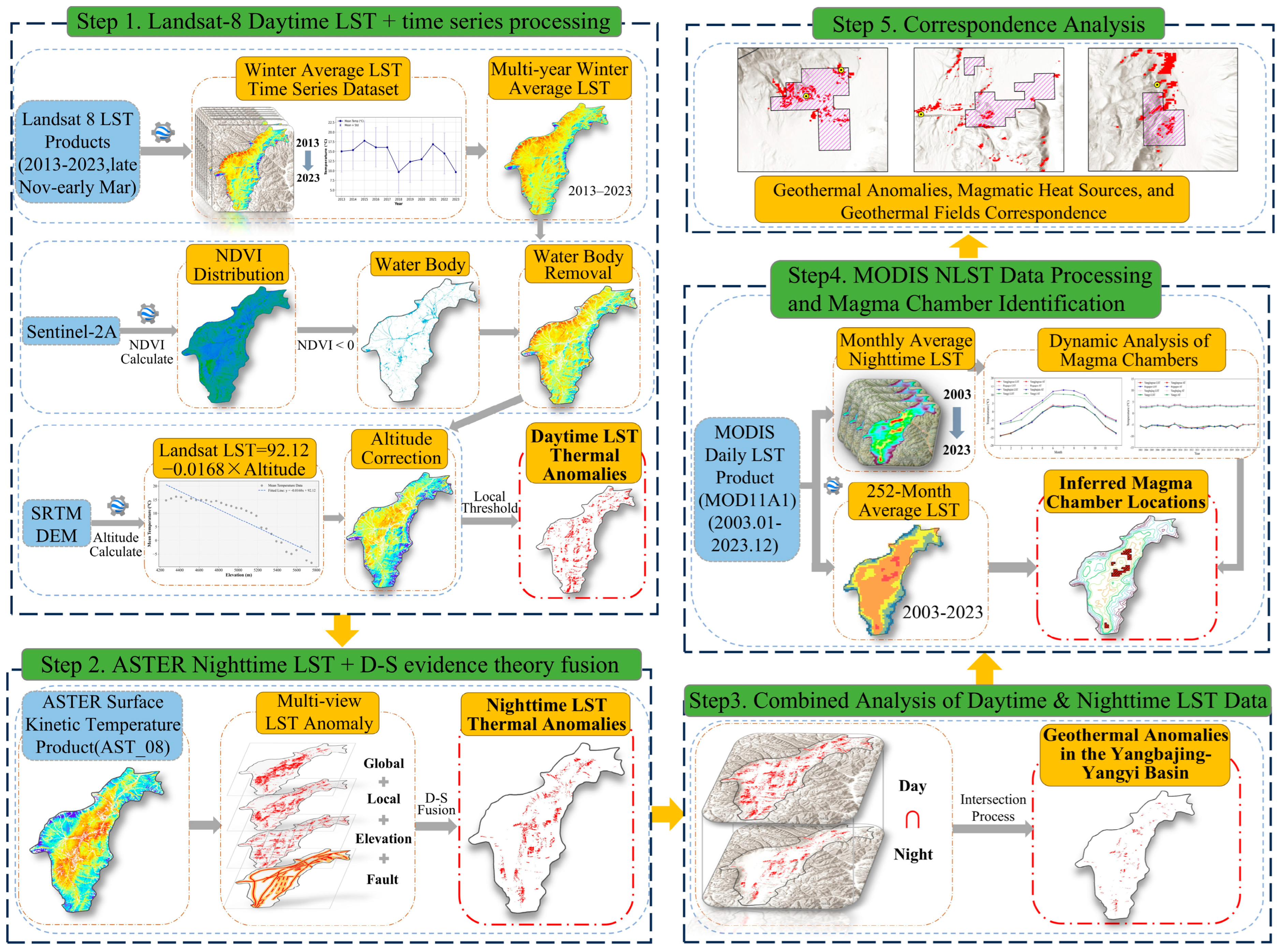
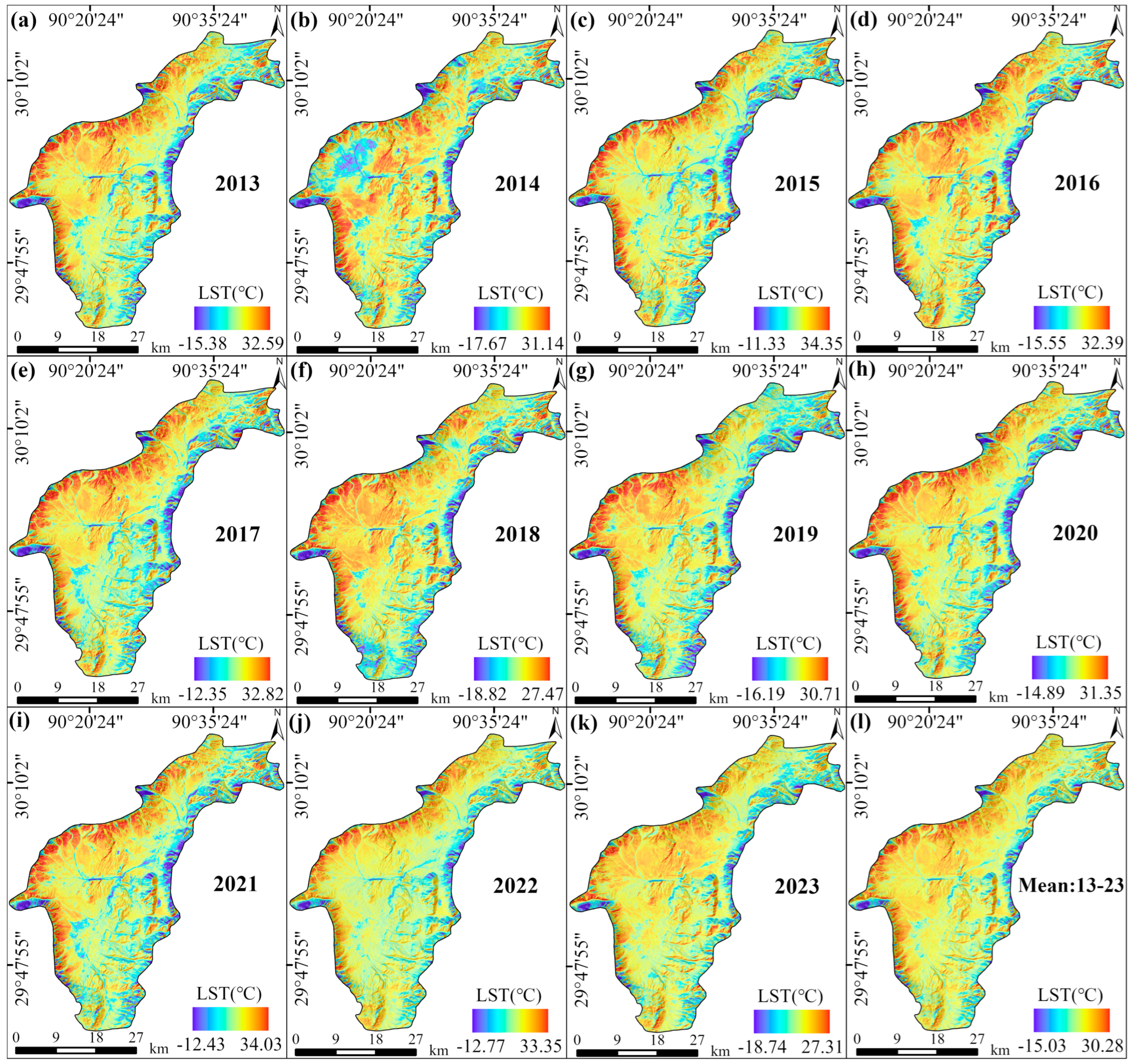

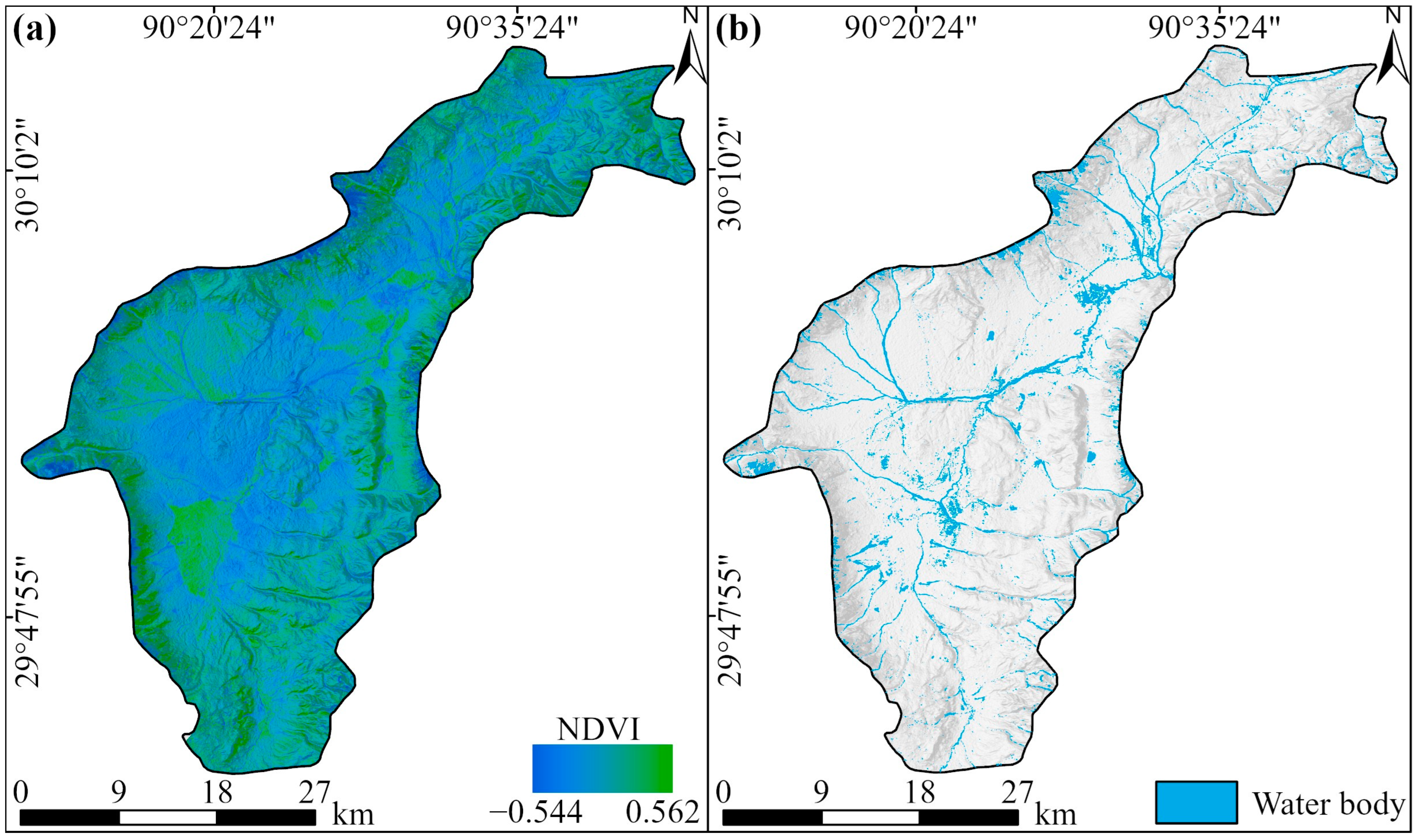
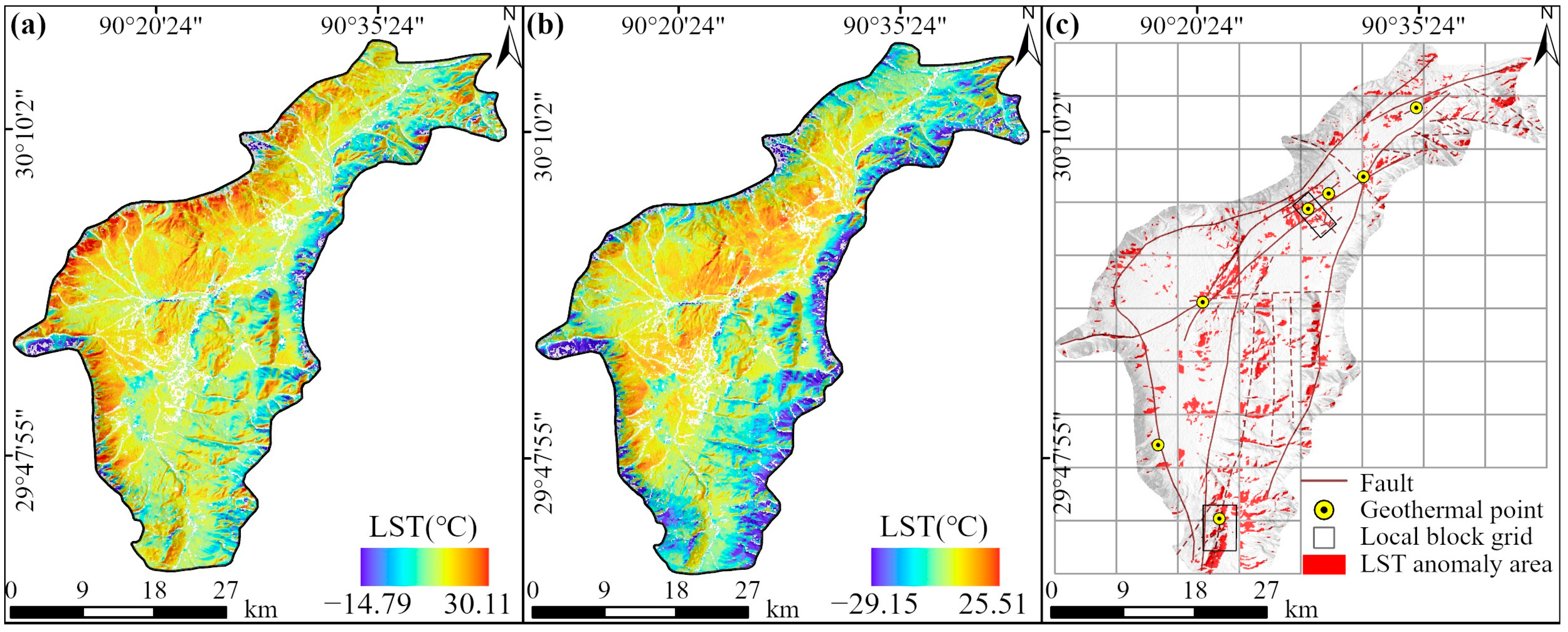
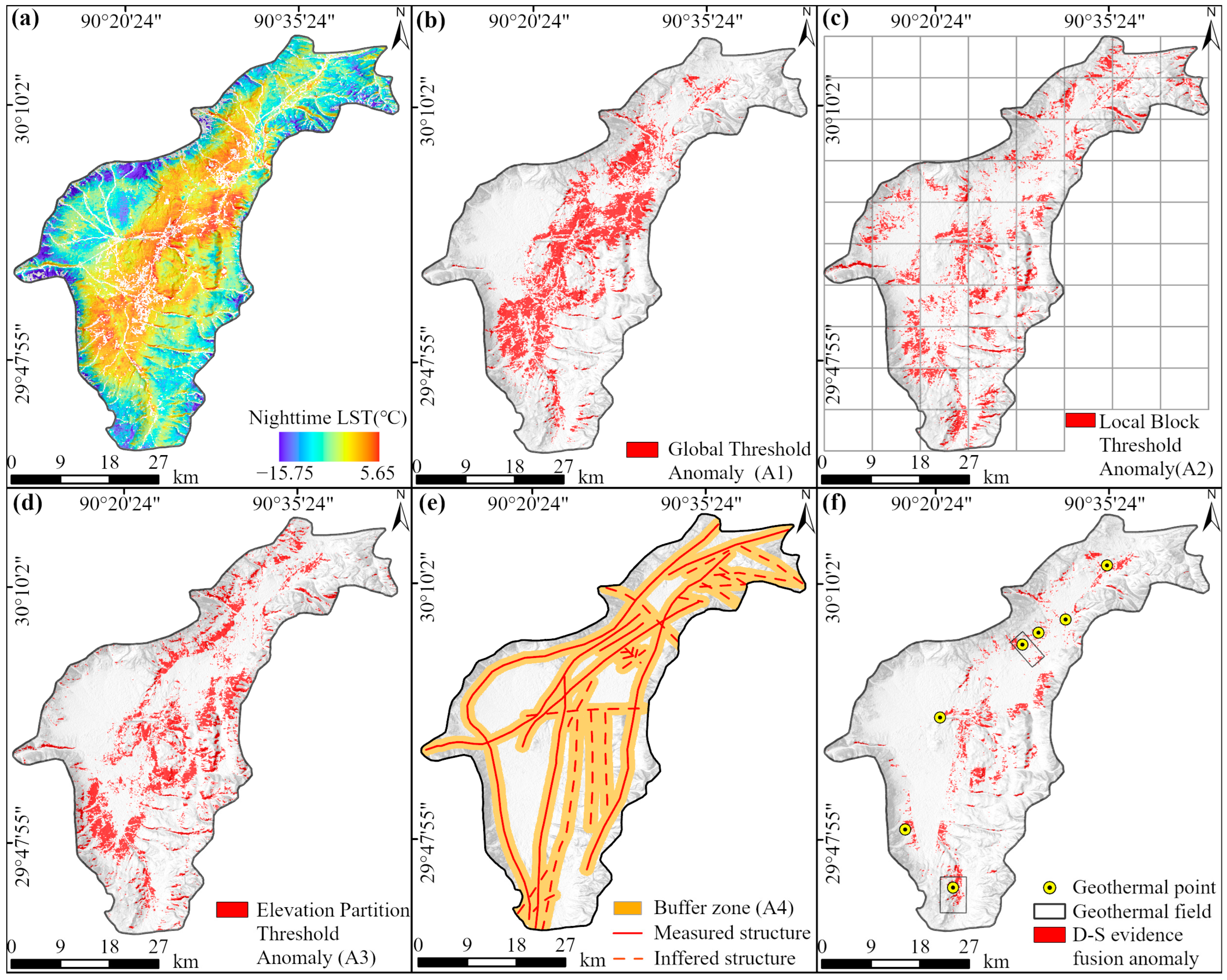
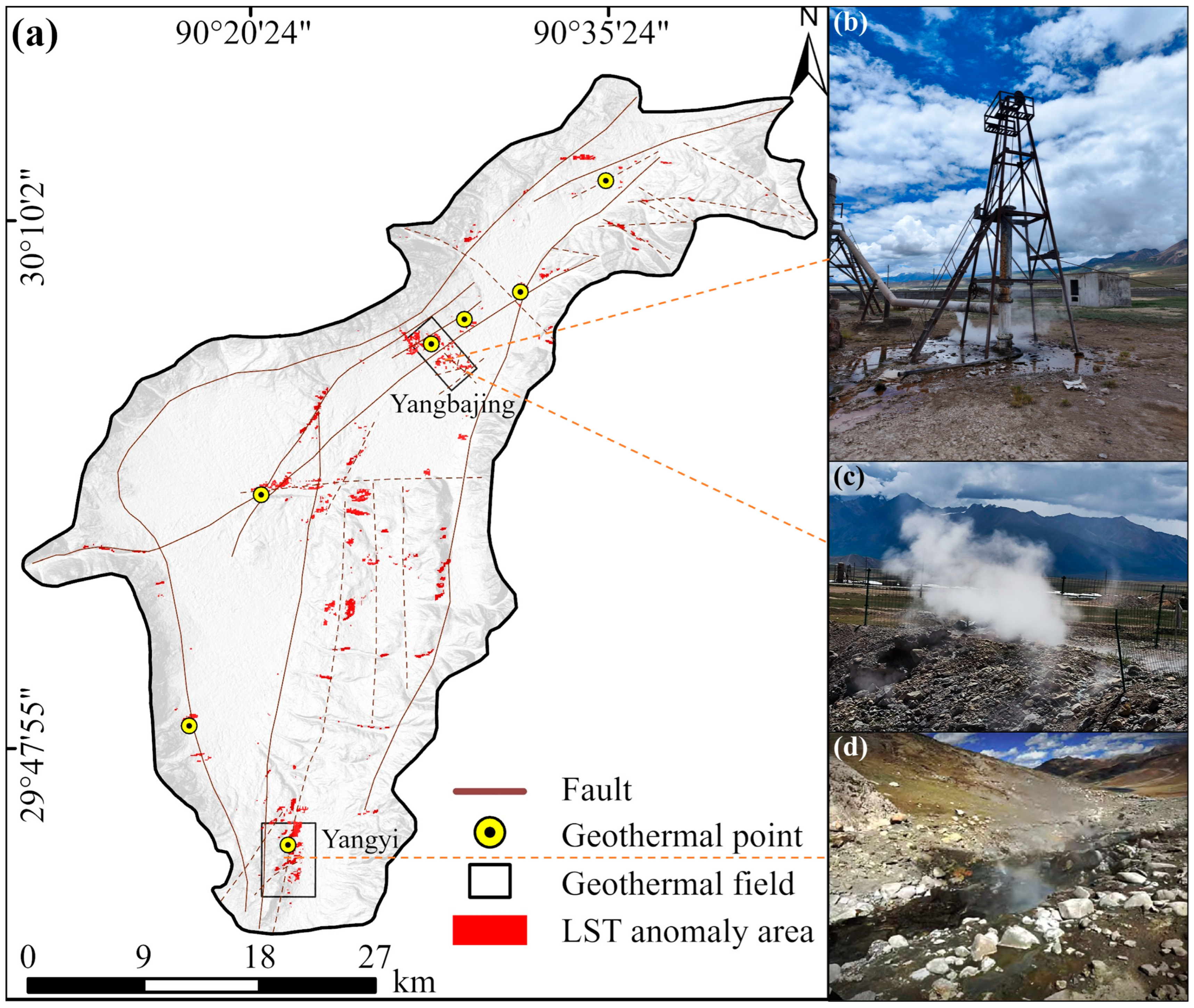
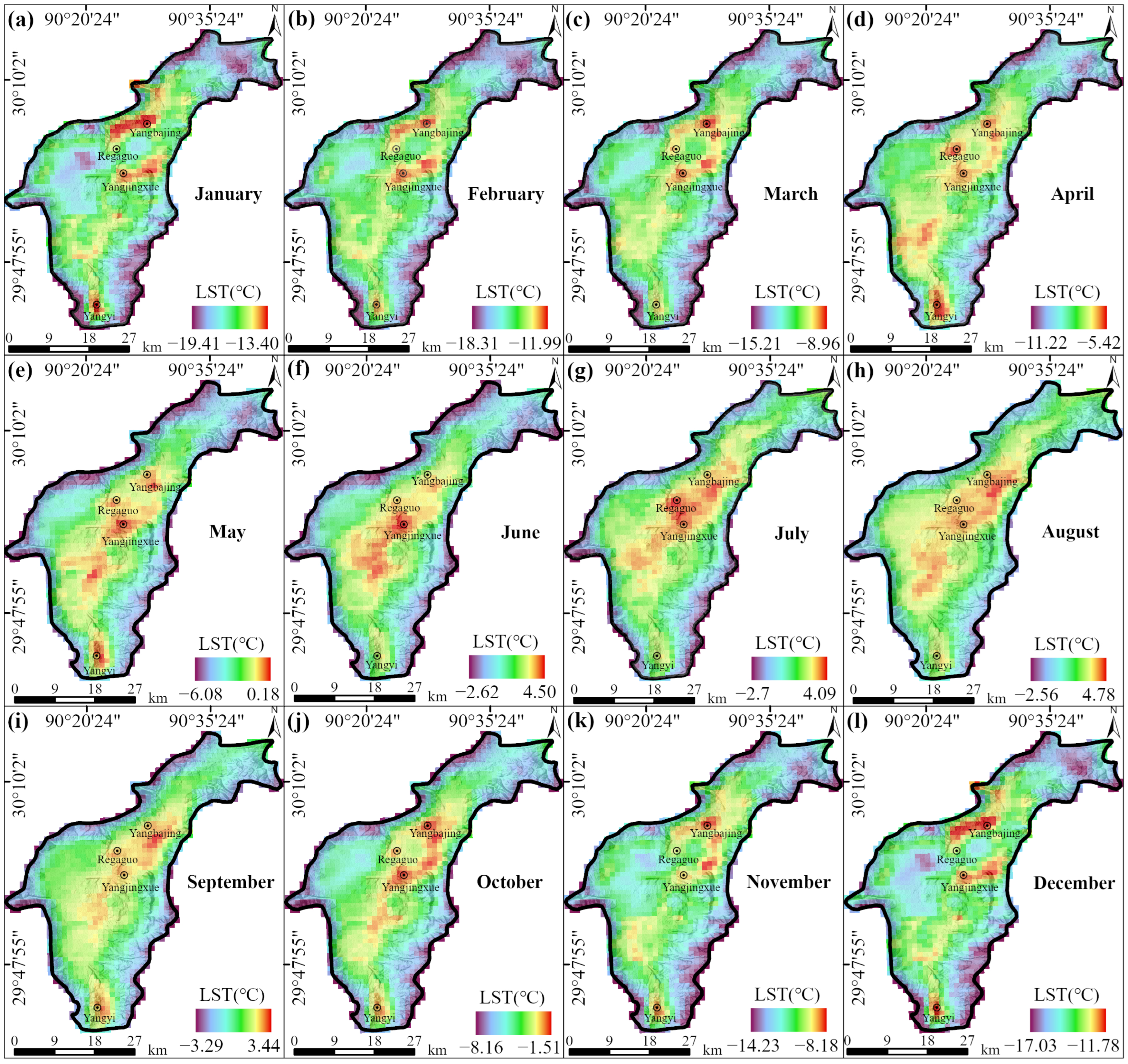

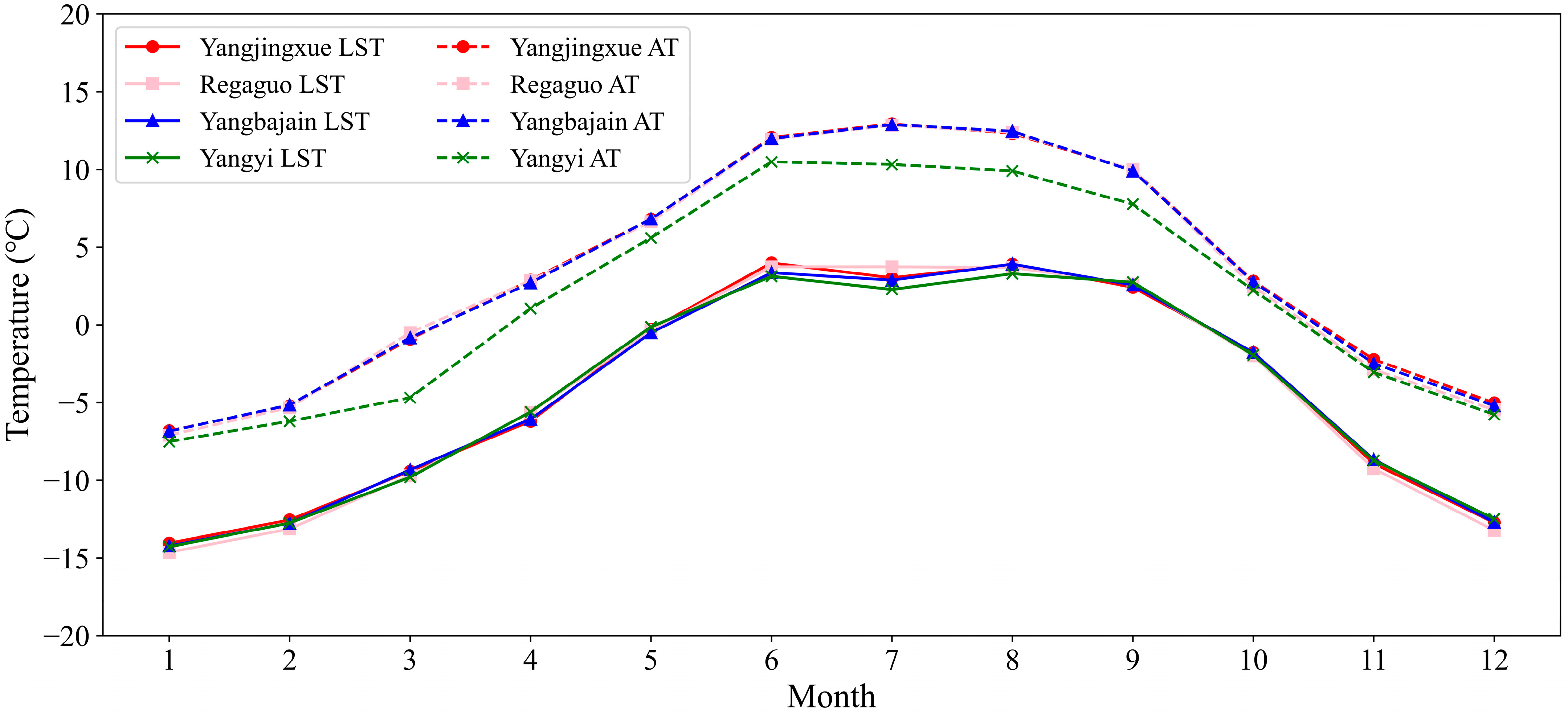
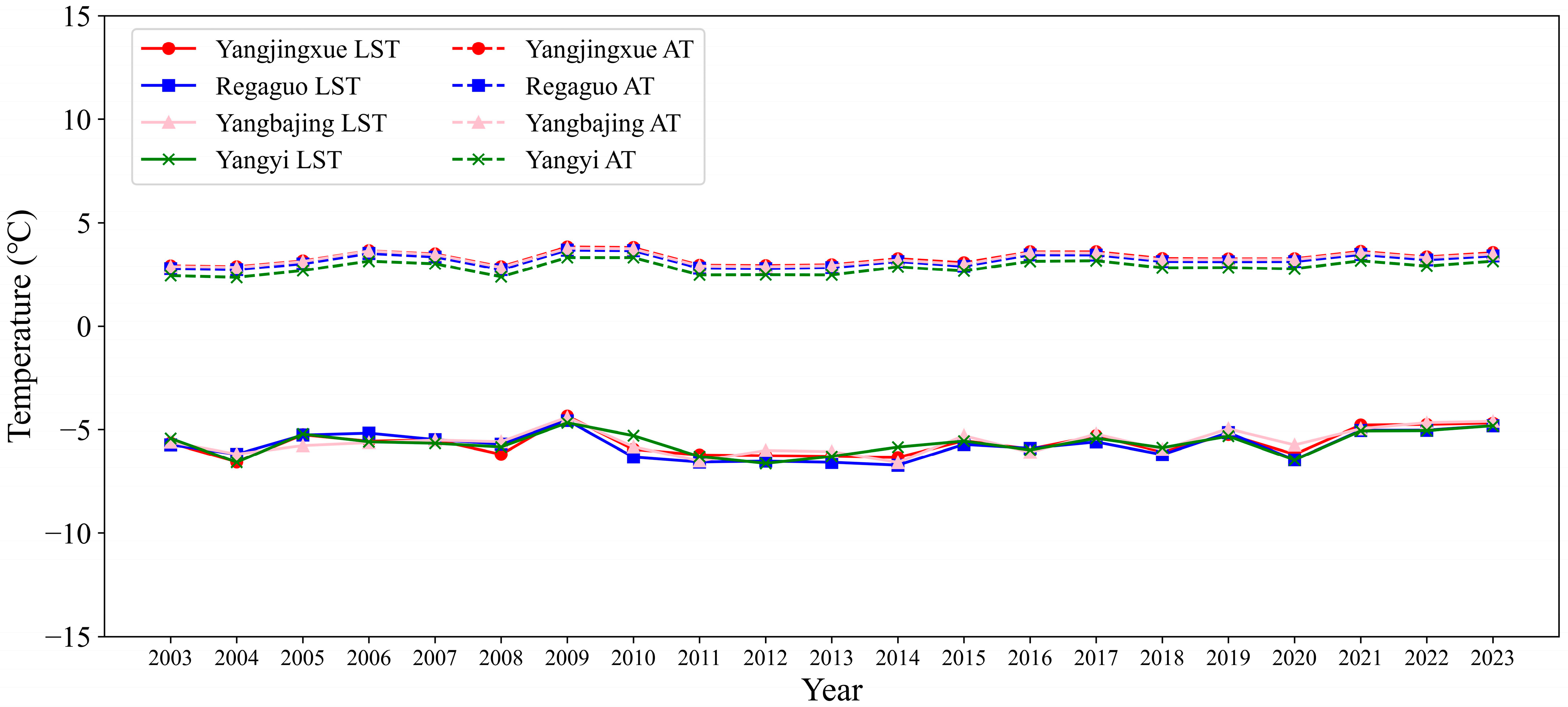
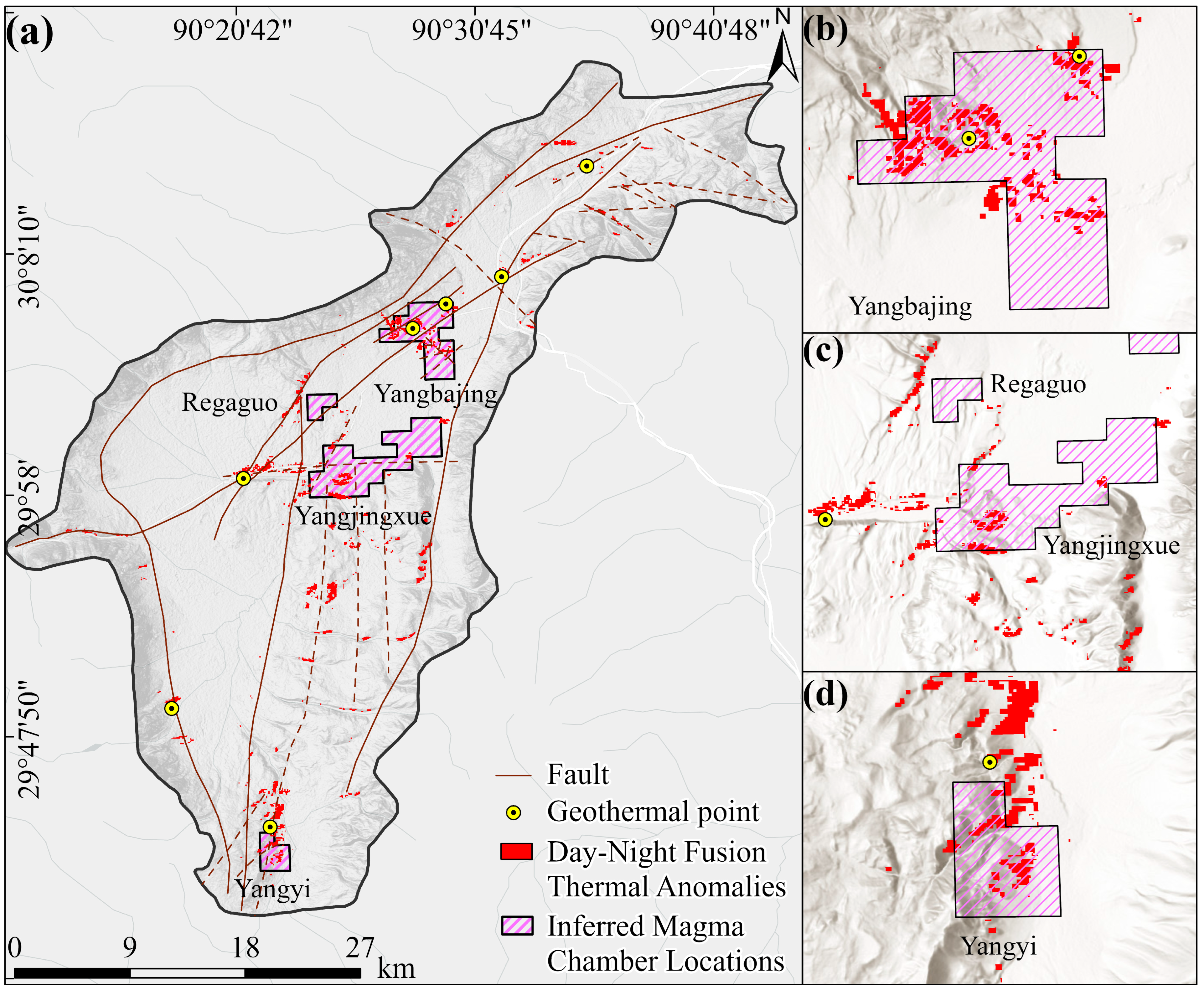
| Dataset | Resolution | Temporal Scope | Data Source | Total Scenes | Processing Steps | Research Role |
|---|---|---|---|---|---|---|
| Landsat-8 TIRS | 100 m | 2013–2023 (Winter: November–March) | USGS Landsat Collection 2 Surface Temperature Product | 134 | 1. Calculate annual winter mean LST and multi-year mean LST (2013–2023) using GEE. 2. Remove water bodies based on NDVI threshold. 3. Perform altitude correction on LST data. 4. Extract thermal anomalies using local threshold segmentation. | Detection of daytime geothermal anomalies through multi-year LST analysis. |
| ASTER LST | 90 m | 3 November 2023, 9 December 2023 | NASA LP DAAC, ASTER Surface Temperature Product (AST_08 V003) | 2 | 1. Extract thermal anomalies using a multi-view approach (global, local, elevation, and structural thresholds). 2. Integrate multi-view data using D–S evidence theory. | Identification of nighttime geothermal anomalies from multiple perspectives. |
| MODIS NLST | 1000 m | 2003–2023 (21 years, 252 months) | NASA LP DAAC, MODIS Land Surface Temperature Daily Product (MOD11A1 V061) | 7640 | 1. Construct a 252-month long-term LST time series. 2. Calculate the 21-year monthly mean LST. 3. Analyze interannual and monthly LST variation trends (2003–2023). | Analysis of magmatic chamber activity and long-term geothermal dynamic evolution. |
Disclaimer/Publisher’s Note: The statements, opinions and data contained in all publications are solely those of the individual author(s) and contributor(s) and not of MDPI and/or the editor(s). MDPI and/or the editor(s) disclaim responsibility for any injury to people or property resulting from any ideas, methods, instructions or products referred to in the content. |
© 2025 by the authors. Licensee MDPI, Basel, Switzerland. This article is an open access article distributed under the terms and conditions of the Creative Commons Attribution (CC BY) license (https://creativecommons.org/licenses/by/4.0/).
Share and Cite
Li, C.; Guo, N.; Li, Y.; Luo, H.; Zhuo, Y.; Deng, S.; Li, X. Enhancing Geothermal Anomaly Detection with Multi-Source Thermal Infrared Data: A Case of the Yangbajing–Yangyi Basin, Tibet. Appl. Sci. 2025, 15, 3740. https://doi.org/10.3390/app15073740
Li C, Guo N, Li Y, Luo H, Zhuo Y, Deng S, Li X. Enhancing Geothermal Anomaly Detection with Multi-Source Thermal Infrared Data: A Case of the Yangbajing–Yangyi Basin, Tibet. Applied Sciences. 2025; 15(7):3740. https://doi.org/10.3390/app15073740
Chicago/Turabian StyleLi, Chunhao, Na Guo, Yubin Li, Haiyang Luo, Yexin Zhuo, Siyuan Deng, and Xuerui Li. 2025. "Enhancing Geothermal Anomaly Detection with Multi-Source Thermal Infrared Data: A Case of the Yangbajing–Yangyi Basin, Tibet" Applied Sciences 15, no. 7: 3740. https://doi.org/10.3390/app15073740
APA StyleLi, C., Guo, N., Li, Y., Luo, H., Zhuo, Y., Deng, S., & Li, X. (2025). Enhancing Geothermal Anomaly Detection with Multi-Source Thermal Infrared Data: A Case of the Yangbajing–Yangyi Basin, Tibet. Applied Sciences, 15(7), 3740. https://doi.org/10.3390/app15073740






